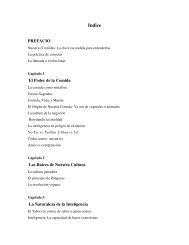The World Peace Diet: Eating For Spiritual Health And Social Harmony
The World Peace Diet: Eating For Spiritual Health And Social Harmony
The World Peace Diet: Eating For Spiritual Health And Social Harmony
You also want an ePaper? Increase the reach of your titles
YUMPU automatically turns print PDFs into web optimized ePapers that Google loves.
Notes / 299<br />
45. John McDougall, “<strong>Diet</strong> and Diabetes: <strong>The</strong> Meat of the Matter,” EarthSave<br />
Magazine, November 2002, p. 4.<br />
46. Ibid., p. 22.<br />
47. Dean Ornish, Eat More, Weigh Less, (New York: HarperCollins, 1993).<br />
48. <strong>For</strong> an informative and eye-opening discussion of the placebo effect in a variety of<br />
medical and healing modalities, see <strong>And</strong>rew Weil, <strong>Health</strong> and Healing, pp.<br />
199–274. See also Lolette Kuby, Faith and the Placebo Effect (Novato, CA: Origin<br />
Press, 2001).<br />
49. Jeffrey Hildner, “Destination: Healing,” <strong>The</strong> Christian Science Journal, November<br />
2003, pp. 6–7.<br />
50. “Subway: <strong>The</strong> New King of Fast Food,” Organic Consumers Association, July<br />
2004. See www.organicconsumers.org/corp/subway071504.cfm.<br />
51. Weil, Eight Weeks to Optimum <strong>Health</strong>, p. 104.<br />
52. Brenda Davis and Vesanto Melina, Becoming Vegan (Summertown, TN: Book<br />
Publishing Company, 2000).<br />
53. <strong>World</strong> <strong>Health</strong> Organization Technical Report Series 916. <strong>Diet</strong>, Nutrition and the<br />
Prevention of Chronic Diseases (Geneva, 2003).<br />
54. European Journal of Clinical Nutrition, 57, August 2003, p. 947. Also, USDA,<br />
Food and Nutrient Intakes by Individuals in the United States, by Region,<br />
1994–1996. Cited in Michael Greger, “Latest in Human Nutrition,” Dr. Michael<br />
Greger’s Monthly Newsletter, September 2003. (www.drgreger.org/september2003.html).<br />
55. Howard Lyman points out in Mad Cowboy (New York: Scribner, 1998, p. 126),<br />
that not only does it take enormous amounts of pesticide-laden grain to make the<br />
animal foods we consume, but also that “ . . . governmental limitations, lax though<br />
they are, on the use of pesticides for human consumption do not apply to crops destined<br />
for livestock. <strong>The</strong> lion’s share of the agrochemical poisons sprayed into the air<br />
and falling onto the ground are dedicated to the production of meat.”<br />
56. Howard Lyman, author of Mad Cowboy, occasionally offers this metaphor in his<br />
public addresses.<br />
Chapter 6—Hunting and Herding Sea Life<br />
1. Farley Mowat, Sea of Slaughter (New York: Atlantic Monthly Press, 1984), p. 404.<br />
2. Minority Staff of the U.S. Senate Committee on Agriculture, Nutrition, and<br />
<strong>For</strong>estry, “Animal Waste Pollution in America: An Emerging National Problem,”<br />
December 1997.<br />
3. Michael Satchel, “<strong>The</strong> Cell from Hell,” U.S. News and <strong>World</strong> Report, July 28,<br />
1997, pp. 26–28.<br />
4. Tim Beardsley, “Death in the Deep: ‘Dead Zone’ in the Gulf of Mexico Challenges<br />
Regulators,” Scientific American, November 1997, pp. 17–18.<br />
5. Lewis Regenstein, How to Survive in America the Poisoned (New York: Acropolis,<br />
1982), p. 103.<br />
6. K. Noren, “Levels of organochloride contaminants in human milk in relation to the<br />
dietary habits of the mothers,” Acta Paediatrica Scandinavica, 72(6), November<br />
1983, pp. 811–816.<br />
7. Michael Klaper, Vegan Nutrition: Pure and Simple (Paia, HI: Gentle <strong>World</strong>, 1998),<br />
pp. 26–27. This passage from the book is slightly modified and updated by Dr.<br />
Klaper through his correspondence with the author of February 2004.<br />
8. Brenda Davis and Vesanto Melina, Becoming Vegan (Summertown, TN: Book<br />
Publishing Company, 2000), pp. 60–76.<br />
9. Office of Pollution Prevention and Toxics, EPA, “Management of Polychlorinated<br />
Biphenyls in the United States” (Washington, DC: Government Printing Office, 1997).



